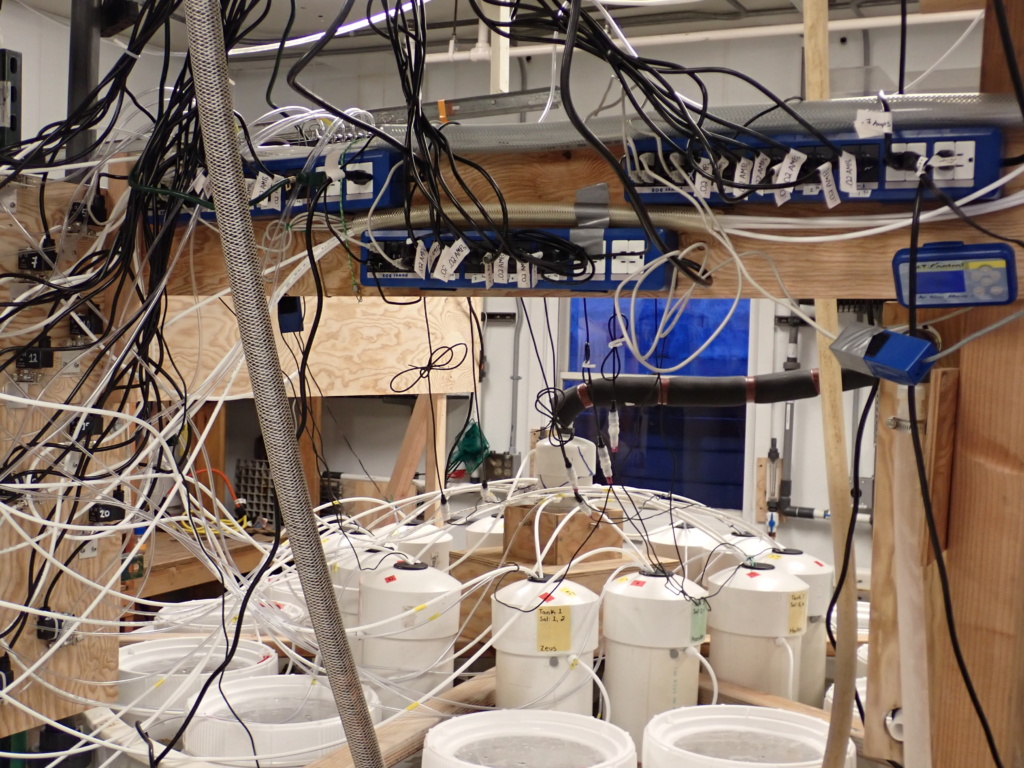Antarctica Put to the Acid Test
April 16, 2020
By Maggie Amsler
The great white continent of Antarctica and its encircling frigid Southern Ocean is one of the most remote and pristine regions of the planet and as such lends itself to a natural laboratory. It is also now one of the planet’s most threatened regions due to climate change. I recently completed a four-month research expedition investigating the effects of climate change on the marine communities in the local, shallow waters. Local meaning Palmer Station, a US research facility on Anvers Island off the western Antarctic Peninsula, which served as both home and laboratory.

Marr Glacier and the ASRV Laurence M. Gould in background. Team members (left to right) Jim
McClintock, Chuck Amsler, Hannah Oswalt and Maggie Amsler all from the University of Alabama at
Birmingham plus Julie Schram (not shown) from the Oregon Institute of Marine Biology
My team and I were not studying the direct effects of the documented increase in air temperature over Antarctica or increase in the Southern Ocean water temperature, yet was reminded of it daily. The Marr Glacier, backdropping Palmer Station, now routinely, and at a much greater frequency than decades ago, cleaves towering ice columns from its leading-edge creating large sonic booms as the massive dense ice break or calve from the parent ice and crash into the harbor waters. Rather, our research focused on the ancillary climate change problem of ocean acidification.

Ocean acidification is a result of the world ocean’s natural tendency to absorb atmospheric gases, in particular carbon dioxide (CO 2). Like glaciers’ natural function of movement has accelerated, oceans’ absorption of CO 2 has increased. Once absorbed, the CO 2 drives chemical changes in the seawater, resulting in excess hydrogen ions floating around which translates into lower seawater pH. Remember from high school chemistry that pH ranges from 0-14 with 7.0 being neutral and anything less is acid. Since the industrial revolution the pH of the world ocean has dropped 0.1 pH units. That may not look like much but pH is on logarithmic scale and means the ocean is now 10% more acid than a century ago. Small changes can have huge consequences on marine life, especially for organisms like mollusks whose shells made of calcium and magnesium and are at risk of dissolution with increasing acidity. Numerous studies already show that some Antarctic mollusks are being affected evidenced by thinning and pitting of shells. Crustaceans, like crabs and lobsters, to a lesser extent also reinforce their external skeletons with calcium and magnesium and thus are also susceptible to skeletal weakening in an acidifying ocean.


Amphipods are crustaceans that are very common in the waters of Southern Ocean and live in great abundance on the rich and diverse stands of kelp-like macroalgae dominated communities found around Palmer Station and much of the Antarctic Peninsula. Ecologically, amphipods are grazers and serve a vital role in maintaining the underwater algal ‘forests’ of Antarctica. About the length of a peanut, amphipods are extremely abundant (and charismatic in my opinion) and many species dutifully busy themselves keeping ‘trees’, kelp-like algae, free of fouling growth on the algae that would interfere with photosynthesis and growth. Just like tree forests are important carbon recyclers so too are algal forests underwater. The association of amphipods and algae are thus pretty important to the overall ecology of the Southern Ocean.

numerous understory shrubby red algae
So we designed an experiment to study what would happen to the amphipods and algae under different ocean acidification scenarios – the acid test. Three different pH treatments were selected: current or ambient of 8.1, the predicted near-future 7.7 and a more distant future pH 7.3. In 24 bucketed oceans we maintained diver-collected representative algae and amphipods for two months in pH specific flow-through seawater. Each bucket was constantly fed water from its own mixing tank into which ambient seawater, air and CO 2 were mixed to maintain the desired seawater pH. Each mixing tank also had its own pH probe that interfaced with a computer that controlled microprocessors to turn on or off an air pump or CO 2 tank to achieve the proper seawater pH delivered into the bucket. An elaborate setup that all totaled had about a football length of air, CO 2 and water tubing – hence the complete setup was dubbed “tubular jungle”.

During the experiment, the amphipods in the two dozen mini-oceans were kept busy grazing on the algae (which for weeks prior to setup had been maintained amphipod-free and seeded with one of their favorite fouling food – diatoms). We were kept busy doing daily water chemistry analyses on each bucket, ensuring adequate water and gas flow, etc. And in a blink of an eye two months had passed and it was time to disassemble all and collect the amphipods to compare who started and who finished. Thousands of amphipods started our marathon experiment and the winners and losers have yet to analyze but we expect that some species did ok, some less ok, and some did really bad.

Let’s hope that we find more winners than losers in at least the near-future ocean acidification scenario. Since colder waters absorb CO 2 at a faster rate than warmer waters the marine algal ‘forest’ communities of Antarctica may well be the harbingers, the canary in the coal mine, of things to come in more temperate regions of the world ocean. Celebrate Earth Day but not only in April as every day should be a recognition of the wonders of our planet and the need to protect and preserve its air, land and water. Planet Earth is more ocean than land and unlike the land, all oceans are connected as one. Each of us lives in a little hope spot and doing our best for our spot contributes to the health of the earth’s atmosphere, lands and ocean – and remotely yet ultimately the waters encircling Antarctica.








